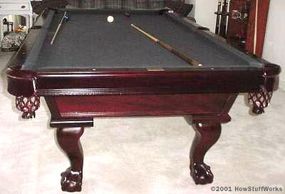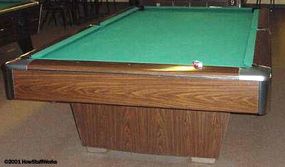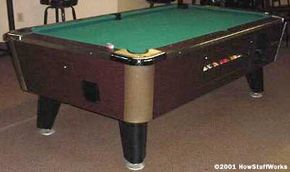Rack 'Em Up
There are a variety of games played on billiard tables. The games are split into two general categories: pocket billiards and carom billiards.
Pocket billiards
Called pool by most people, pocket billiards has six holes (pockets): one in each of the four corners and one in the middle of each long side of the table. An interesting fact is how the name pool came about. As pocket billiards increased in popularity in England in the late 1800s and early 1900s, gambling houses called pool rooms installed the tables as another form of entertainment. They were called pool rooms because people would place bets into a common fund ("pool") that would pay out to the winners. Eventually, the billiards tables proved so popular that they became the predominant entertainment at these establishments and the name "pool room" came to refer to a place where you played pocket billiards, and therefore pocket billiards became "pool."
Advertisement
- 8-ball - Arguably the most popular billiards game in the United States, 8-ball uses 15 numbered balls and a cue ball. One player attempts to "pocket" (put the ball in a hole) balls 1-7 and the other player tries to make balls 9-15. When a player makes all seven of his balls, the player attempts to make the 8 ball in a specific pocket. If he does so and does not also pocket the cue ball, he wins the game.
- 9-ball - One of the quickest and simplest forms of billiards, 9-ball uses 9 numbered balls and a cue ball. Players are required to shoot at the lowest ball on the table, beginning with the 1 ball. Whichever player makes the 9 ball in a way that is within the rules wins the game.
- Snooker - While 8-ball is the game in the United States, English players favor this game, which uses 21 colored balls and a cue ball. 15 of the balls are red and count as one point each when pocketed. The other balls include one each of yellow, green, brown, blue, pink and black, with point values ranging from 2-7 respectively. A player must first make a red ball before attempting to pocket any of the other colors, which must be made in order of their value. When a player is left without a clear shot, they are said to be "snookered." The term "snooker" originally referred to a recruit in the British Army, where this game originated.
- Straight pool - Also known as 14.1 continuous pool, straight pool uses 15 numbered balls and a cue ball. A player attempts to make the balls in any order, but must specify which ball and what pocket he plans to make it in. When there is only one ball left on the table, the other 14 are racked again and the player attempts to break them apart while making the other ball. A point is given for each ball made with the required number of points to win normally set at 150.
- One pocket - This game is played with 15 numbered balls and a cue ball. Before play commences, the first player chooses one of the corner pockets at the foot end of the table. His opponent then has the other corner pocket at that end. Each player attempts to make balls in their pocket, gaining a point for each one made. Points are subtracted for making balls in other pockets or scratching (making the cue ball).
- English billiards - Played with only three balls, there are also three specific ways to score. The player can make the ball he strikes deflect off another ball and into a pocket. He can hit one ball and make it strike the other two balls. Or he can strike a ball and make it knock another ball into a pocket.
Carom Billiards
These games are played on tables without any pockets. Both variations are played with three balls, one white, one red and a white ball with a red spot.
- French billiards - The player chooses one of the two white balls as his cue ball. He must then cause the cue ball to hit the other two balls.
- Three-cushion billiards - This variation requires that the cue ball strike one or more cushions three times before contacting any object balls.
Table Designs


There are nearly as many types of tables as there are variations on billiards.
The information below lists the specifications of some of the more common table designs.
Snooker
- 12 ft (3.7 m) x 6.1 ft (1.9 m)
- Pockets
English billiards
- 12 ft (3.7 m) x 6.1 ft (1.9 m)
- Pockets
Carom professional
- 10 ft (3 m) x 5 ft (1.5 m)
- No pockets
Tournament
- 9 ft (2.7 m) x 4.5 ft (1.4 m)
- Pockets
Carom standard
- 9 ft (2.7 m) x 4.5 ft (1.4 m)
- No pockets
Pro-8
- 8.3 ft (2.5 m) x 4.15 ft (1.25 m)
- Pockets
Standard
- 8 ft (2.4 m) x 4 ft (1.2 m)
- Pockets
Bar
- 7 ft (2.2 m) x 3.5 ft (1.1 m)
- Pockets
Economy
- 6 ft (1.8 m) x 3 ft (0.9 m)
- Pockets
The tables listed above are the most common, but you can find billiards tables in all shapes and sizes. A version that you sometimes see is called bumper pool and has rubber columns (bumpers) arranged on the playing surface. Most of these tables are round or octagonal in shape and have one or more pockets between the bumpers.
Billiards is an exciting and challenging sport that can be enjoyed by everyone. If you can hold a cue and hit the balls with it, you can play a basic game of billiards. But, like any worthy skill, excellence at the sport does require practice and an understanding of the equipment.
For more information on billiards and related topics, check out the links below.
